Research Project: Assessing Dementia Factors in UK Women vs Men
VerifiedAdded on 2020/01/07
|20
|7513
|207
Project
AI Summary
This research project investigates the factors contributing to the higher prevalence of dementia in women compared to men in the UK. The project begins with an introduction outlining the rationale, aims, objectives, literature review, methodology, and structure. The literature review explores existing research on dementia, highlighting the differing experiences and symptoms in men and women, and examining the roles of age, genetics, and lifestyle factors. The methodology section details the inductive research approach, qualitative data collection, and thematic analysis. The project emphasizes the importance of ethical considerations, including proper citation, plagiarism prevention, and confidentiality. The findings suggest that various factors, including longer lifespans, societal roles, and potential biological differences, contribute to the disparity. The project concludes with recommendations for further study, such as exploring specific interventions to mitigate dementia risk in women. Desklib provides this assignment and other study resources for students.

RESEARCH PROJECT
Paraphrase This Document
Need a fresh take? Get an instant paraphrase of this document with our AI Paraphraser
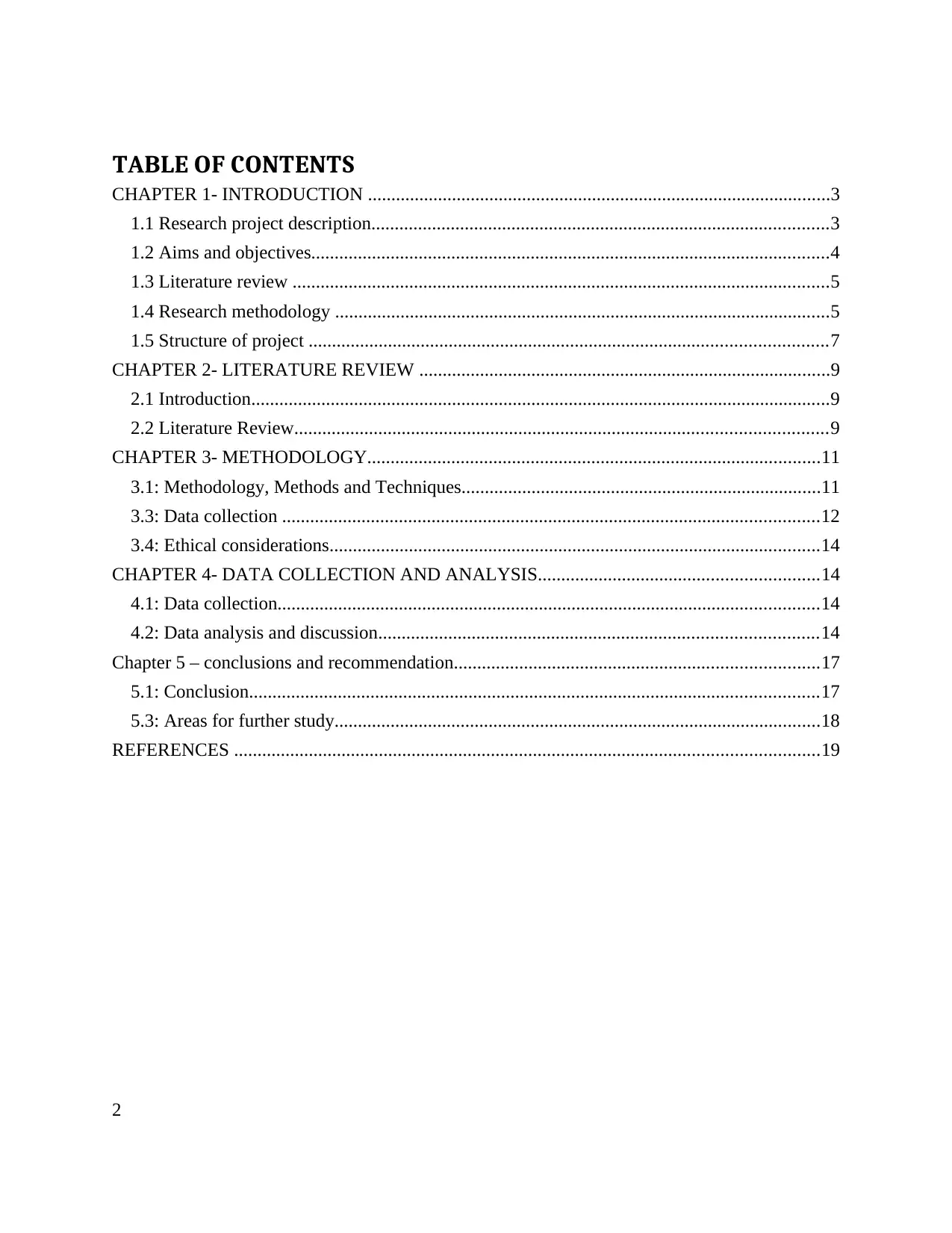
TABLE OF CONTENTS
CHAPTER 1- INTRODUCTION ...................................................................................................3
1.1 Research project description..................................................................................................3
1.2 Aims and objectives...............................................................................................................4
1.3 Literature review ...................................................................................................................5
1.4 Research methodology ..........................................................................................................5
1.5 Structure of project ...............................................................................................................7
CHAPTER 2- LITERATURE REVIEW ........................................................................................9
2.1 Introduction............................................................................................................................9
2.2 Literature Review..................................................................................................................9
CHAPTER 3- METHODOLOGY.................................................................................................11
3.1: Methodology, Methods and Techniques.............................................................................11
3.3: Data collection ...................................................................................................................12
3.4: Ethical considerations.........................................................................................................14
CHAPTER 4- DATA COLLECTION AND ANALYSIS............................................................14
4.1: Data collection....................................................................................................................14
4.2: Data analysis and discussion..............................................................................................14
Chapter 5 – conclusions and recommendation..............................................................................17
5.1: Conclusion..........................................................................................................................17
5.3: Areas for further study........................................................................................................18
REFERENCES .............................................................................................................................19
2
CHAPTER 1- INTRODUCTION ...................................................................................................3
1.1 Research project description..................................................................................................3
1.2 Aims and objectives...............................................................................................................4
1.3 Literature review ...................................................................................................................5
1.4 Research methodology ..........................................................................................................5
1.5 Structure of project ...............................................................................................................7
CHAPTER 2- LITERATURE REVIEW ........................................................................................9
2.1 Introduction............................................................................................................................9
2.2 Literature Review..................................................................................................................9
CHAPTER 3- METHODOLOGY.................................................................................................11
3.1: Methodology, Methods and Techniques.............................................................................11
3.3: Data collection ...................................................................................................................12
3.4: Ethical considerations.........................................................................................................14
CHAPTER 4- DATA COLLECTION AND ANALYSIS............................................................14
4.1: Data collection....................................................................................................................14
4.2: Data analysis and discussion..............................................................................................14
Chapter 5 – conclusions and recommendation..............................................................................17
5.1: Conclusion..........................................................................................................................17
5.3: Areas for further study........................................................................................................18
REFERENCES .............................................................................................................................19
2
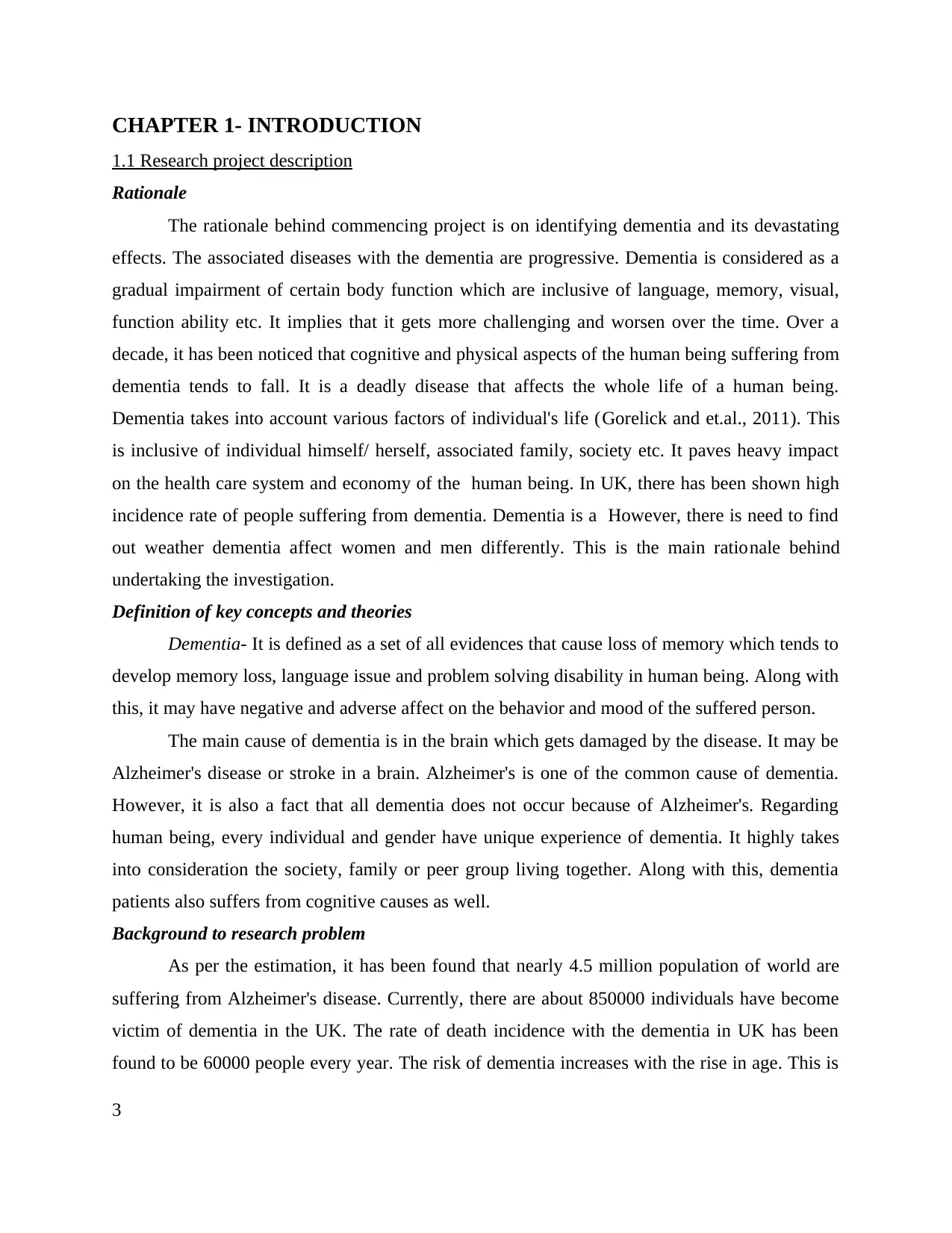
CHAPTER 1- INTRODUCTION
1.1 Research project description
Rationale
The rationale behind commencing project is on identifying dementia and its devastating
effects. The associated diseases with the dementia are progressive. Dementia is considered as a
gradual impairment of certain body function which are inclusive of language, memory, visual,
function ability etc. It implies that it gets more challenging and worsen over the time. Over a
decade, it has been noticed that cognitive and physical aspects of the human being suffering from
dementia tends to fall. It is a deadly disease that affects the whole life of a human being.
Dementia takes into account various factors of individual's life (Gorelick and et.al., 2011). This
is inclusive of individual himself/ herself, associated family, society etc. It paves heavy impact
on the health care system and economy of the human being. In UK, there has been shown high
incidence rate of people suffering from dementia. Dementia is a However, there is need to find
out weather dementia affect women and men differently. This is the main rationale behind
undertaking the investigation.
Definition of key concepts and theories
Dementia- It is defined as a set of all evidences that cause loss of memory which tends to
develop memory loss, language issue and problem solving disability in human being. Along with
this, it may have negative and adverse affect on the behavior and mood of the suffered person.
The main cause of dementia is in the brain which gets damaged by the disease. It may be
Alzheimer's disease or stroke in a brain. Alzheimer's is one of the common cause of dementia.
However, it is also a fact that all dementia does not occur because of Alzheimer's. Regarding
human being, every individual and gender have unique experience of dementia. It highly takes
into consideration the society, family or peer group living together. Along with this, dementia
patients also suffers from cognitive causes as well.
Background to research problem
As per the estimation, it has been found that nearly 4.5 million population of world are
suffering from Alzheimer's disease. Currently, there are about 850000 individuals have become
victim of dementia in the UK. The rate of death incidence with the dementia in UK has been
found to be 60000 people every year. The risk of dementia increases with the rise in age. This is
3
1.1 Research project description
Rationale
The rationale behind commencing project is on identifying dementia and its devastating
effects. The associated diseases with the dementia are progressive. Dementia is considered as a
gradual impairment of certain body function which are inclusive of language, memory, visual,
function ability etc. It implies that it gets more challenging and worsen over the time. Over a
decade, it has been noticed that cognitive and physical aspects of the human being suffering from
dementia tends to fall. It is a deadly disease that affects the whole life of a human being.
Dementia takes into account various factors of individual's life (Gorelick and et.al., 2011). This
is inclusive of individual himself/ herself, associated family, society etc. It paves heavy impact
on the health care system and economy of the human being. In UK, there has been shown high
incidence rate of people suffering from dementia. Dementia is a However, there is need to find
out weather dementia affect women and men differently. This is the main rationale behind
undertaking the investigation.
Definition of key concepts and theories
Dementia- It is defined as a set of all evidences that cause loss of memory which tends to
develop memory loss, language issue and problem solving disability in human being. Along with
this, it may have negative and adverse affect on the behavior and mood of the suffered person.
The main cause of dementia is in the brain which gets damaged by the disease. It may be
Alzheimer's disease or stroke in a brain. Alzheimer's is one of the common cause of dementia.
However, it is also a fact that all dementia does not occur because of Alzheimer's. Regarding
human being, every individual and gender have unique experience of dementia. It highly takes
into consideration the society, family or peer group living together. Along with this, dementia
patients also suffers from cognitive causes as well.
Background to research problem
As per the estimation, it has been found that nearly 4.5 million population of world are
suffering from Alzheimer's disease. Currently, there are about 850000 individuals have become
victim of dementia in the UK. The rate of death incidence with the dementia in UK has been
found to be 60000 people every year. The risk of dementia increases with the rise in age. This is
3
⊘ This is a preview!⊘
Do you want full access?
Subscribe today to unlock all pages.

Trusted by 1+ million students worldwide
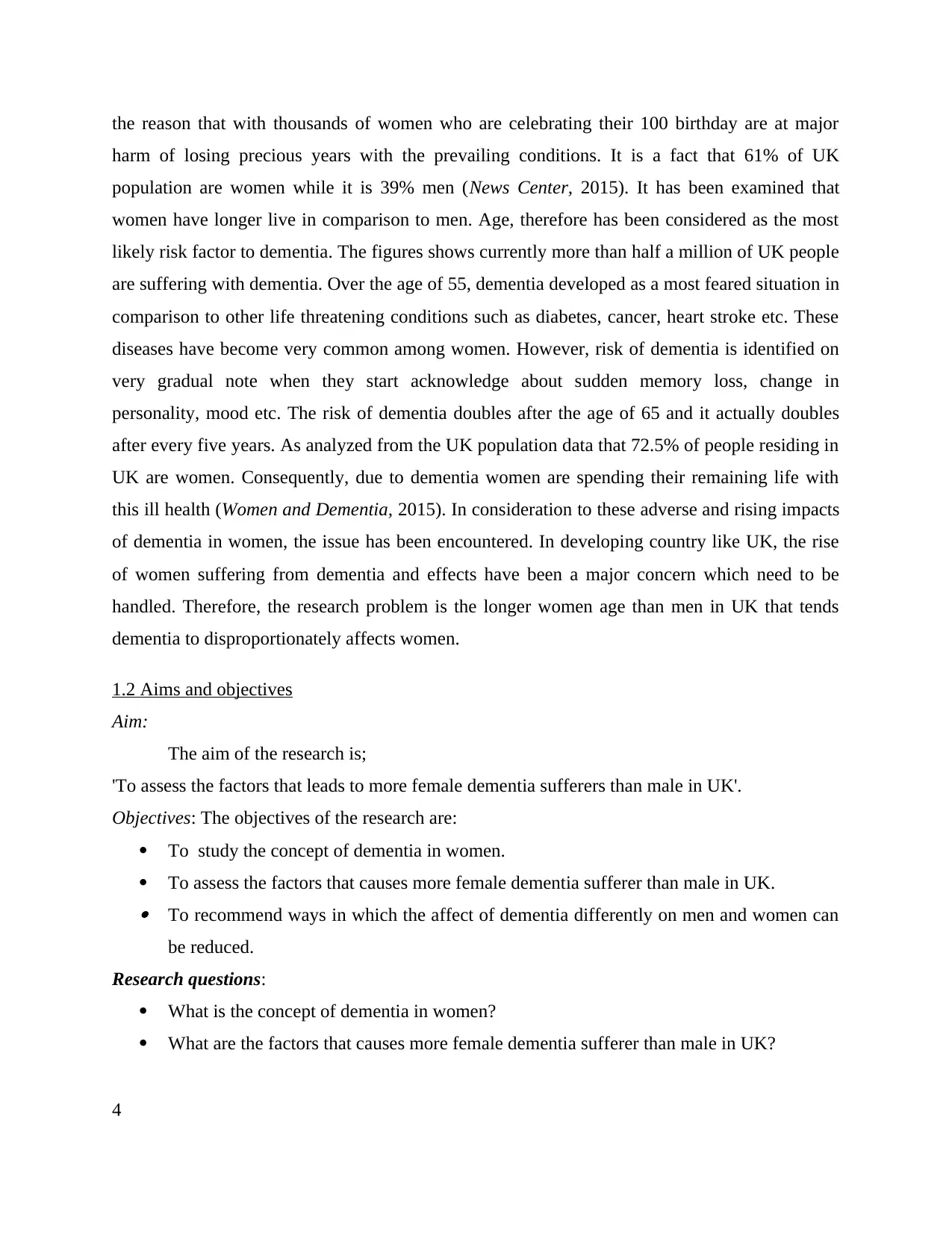
the reason that with thousands of women who are celebrating their 100 birthday are at major
harm of losing precious years with the prevailing conditions. It is a fact that 61% of UK
population are women while it is 39% men (News Center, 2015). It has been examined that
women have longer live in comparison to men. Age, therefore has been considered as the most
likely risk factor to dementia. The figures shows currently more than half a million of UK people
are suffering with dementia. Over the age of 55, dementia developed as a most feared situation in
comparison to other life threatening conditions such as diabetes, cancer, heart stroke etc. These
diseases have become very common among women. However, risk of dementia is identified on
very gradual note when they start acknowledge about sudden memory loss, change in
personality, mood etc. The risk of dementia doubles after the age of 65 and it actually doubles
after every five years. As analyzed from the UK population data that 72.5% of people residing in
UK are women. Consequently, due to dementia women are spending their remaining life with
this ill health (Women and Dementia, 2015). In consideration to these adverse and rising impacts
of dementia in women, the issue has been encountered. In developing country like UK, the rise
of women suffering from dementia and effects have been a major concern which need to be
handled. Therefore, the research problem is the longer women age than men in UK that tends
dementia to disproportionately affects women.
1.2 Aims and objectives
Aim:
The aim of the research is;
'To assess the factors that leads to more female dementia sufferers than male in UK'.
Objectives: The objectives of the research are:
To study the concept of dementia in women.
To assess the factors that causes more female dementia sufferer than male in UK. To recommend ways in which the affect of dementia differently on men and women can
be reduced.
Research questions:
What is the concept of dementia in women?
What are the factors that causes more female dementia sufferer than male in UK?
4
harm of losing precious years with the prevailing conditions. It is a fact that 61% of UK
population are women while it is 39% men (News Center, 2015). It has been examined that
women have longer live in comparison to men. Age, therefore has been considered as the most
likely risk factor to dementia. The figures shows currently more than half a million of UK people
are suffering with dementia. Over the age of 55, dementia developed as a most feared situation in
comparison to other life threatening conditions such as diabetes, cancer, heart stroke etc. These
diseases have become very common among women. However, risk of dementia is identified on
very gradual note when they start acknowledge about sudden memory loss, change in
personality, mood etc. The risk of dementia doubles after the age of 65 and it actually doubles
after every five years. As analyzed from the UK population data that 72.5% of people residing in
UK are women. Consequently, due to dementia women are spending their remaining life with
this ill health (Women and Dementia, 2015). In consideration to these adverse and rising impacts
of dementia in women, the issue has been encountered. In developing country like UK, the rise
of women suffering from dementia and effects have been a major concern which need to be
handled. Therefore, the research problem is the longer women age than men in UK that tends
dementia to disproportionately affects women.
1.2 Aims and objectives
Aim:
The aim of the research is;
'To assess the factors that leads to more female dementia sufferers than male in UK'.
Objectives: The objectives of the research are:
To study the concept of dementia in women.
To assess the factors that causes more female dementia sufferer than male in UK. To recommend ways in which the affect of dementia differently on men and women can
be reduced.
Research questions:
What is the concept of dementia in women?
What are the factors that causes more female dementia sufferer than male in UK?
4
Paraphrase This Document
Need a fresh take? Get an instant paraphrase of this document with our AI Paraphraser
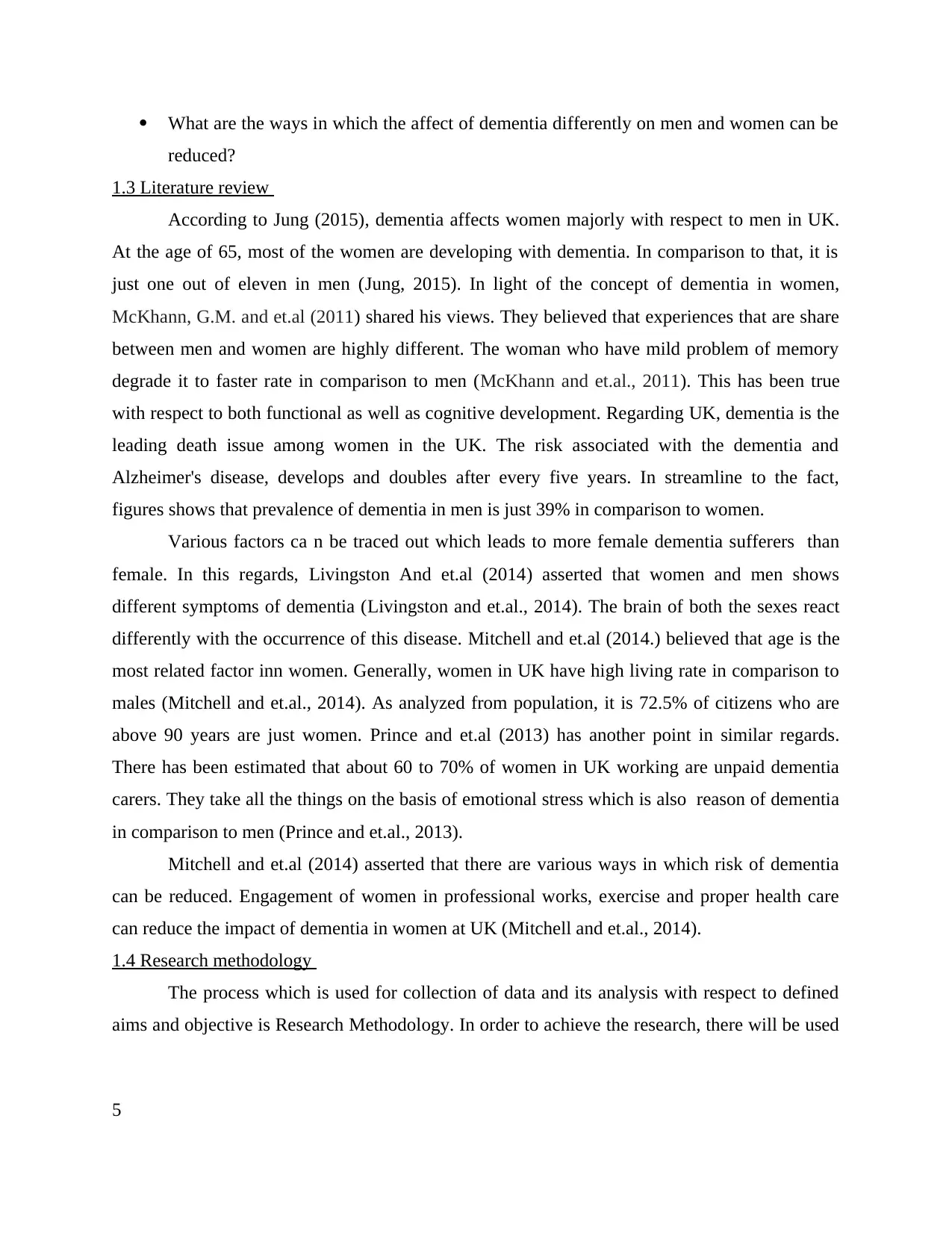
What are the ways in which the affect of dementia differently on men and women can be
reduced?
1.3 Literature review
According to Jung (2015), dementia affects women majorly with respect to men in UK.
At the age of 65, most of the women are developing with dementia. In comparison to that, it is
just one out of eleven in men (Jung, 2015). In light of the concept of dementia in women,
McKhann, G.M. and et.al (2011) shared his views. They believed that experiences that are share
between men and women are highly different. The woman who have mild problem of memory
degrade it to faster rate in comparison to men (McKhann and et.al., 2011). This has been true
with respect to both functional as well as cognitive development. Regarding UK, dementia is the
leading death issue among women in the UK. The risk associated with the dementia and
Alzheimer's disease, develops and doubles after every five years. In streamline to the fact,
figures shows that prevalence of dementia in men is just 39% in comparison to women.
Various factors ca n be traced out which leads to more female dementia sufferers than
female. In this regards, Livingston And et.al (2014) asserted that women and men shows
different symptoms of dementia (Livingston and et.al., 2014). The brain of both the sexes react
differently with the occurrence of this disease. Mitchell and et.al (2014.) believed that age is the
most related factor inn women. Generally, women in UK have high living rate in comparison to
males (Mitchell and et.al., 2014). As analyzed from population, it is 72.5% of citizens who are
above 90 years are just women. Prince and et.al (2013) has another point in similar regards.
There has been estimated that about 60 to 70% of women in UK working are unpaid dementia
carers. They take all the things on the basis of emotional stress which is also reason of dementia
in comparison to men (Prince and et.al., 2013).
Mitchell and et.al (2014) asserted that there are various ways in which risk of dementia
can be reduced. Engagement of women in professional works, exercise and proper health care
can reduce the impact of dementia in women at UK (Mitchell and et.al., 2014).
1.4 Research methodology
The process which is used for collection of data and its analysis with respect to defined
aims and objective is Research Methodology. In order to achieve the research, there will be used
5
reduced?
1.3 Literature review
According to Jung (2015), dementia affects women majorly with respect to men in UK.
At the age of 65, most of the women are developing with dementia. In comparison to that, it is
just one out of eleven in men (Jung, 2015). In light of the concept of dementia in women,
McKhann, G.M. and et.al (2011) shared his views. They believed that experiences that are share
between men and women are highly different. The woman who have mild problem of memory
degrade it to faster rate in comparison to men (McKhann and et.al., 2011). This has been true
with respect to both functional as well as cognitive development. Regarding UK, dementia is the
leading death issue among women in the UK. The risk associated with the dementia and
Alzheimer's disease, develops and doubles after every five years. In streamline to the fact,
figures shows that prevalence of dementia in men is just 39% in comparison to women.
Various factors ca n be traced out which leads to more female dementia sufferers than
female. In this regards, Livingston And et.al (2014) asserted that women and men shows
different symptoms of dementia (Livingston and et.al., 2014). The brain of both the sexes react
differently with the occurrence of this disease. Mitchell and et.al (2014.) believed that age is the
most related factor inn women. Generally, women in UK have high living rate in comparison to
males (Mitchell and et.al., 2014). As analyzed from population, it is 72.5% of citizens who are
above 90 years are just women. Prince and et.al (2013) has another point in similar regards.
There has been estimated that about 60 to 70% of women in UK working are unpaid dementia
carers. They take all the things on the basis of emotional stress which is also reason of dementia
in comparison to men (Prince and et.al., 2013).
Mitchell and et.al (2014) asserted that there are various ways in which risk of dementia
can be reduced. Engagement of women in professional works, exercise and proper health care
can reduce the impact of dementia in women at UK (Mitchell and et.al., 2014).
1.4 Research methodology
The process which is used for collection of data and its analysis with respect to defined
aims and objective is Research Methodology. In order to achieve the research, there will be used
5
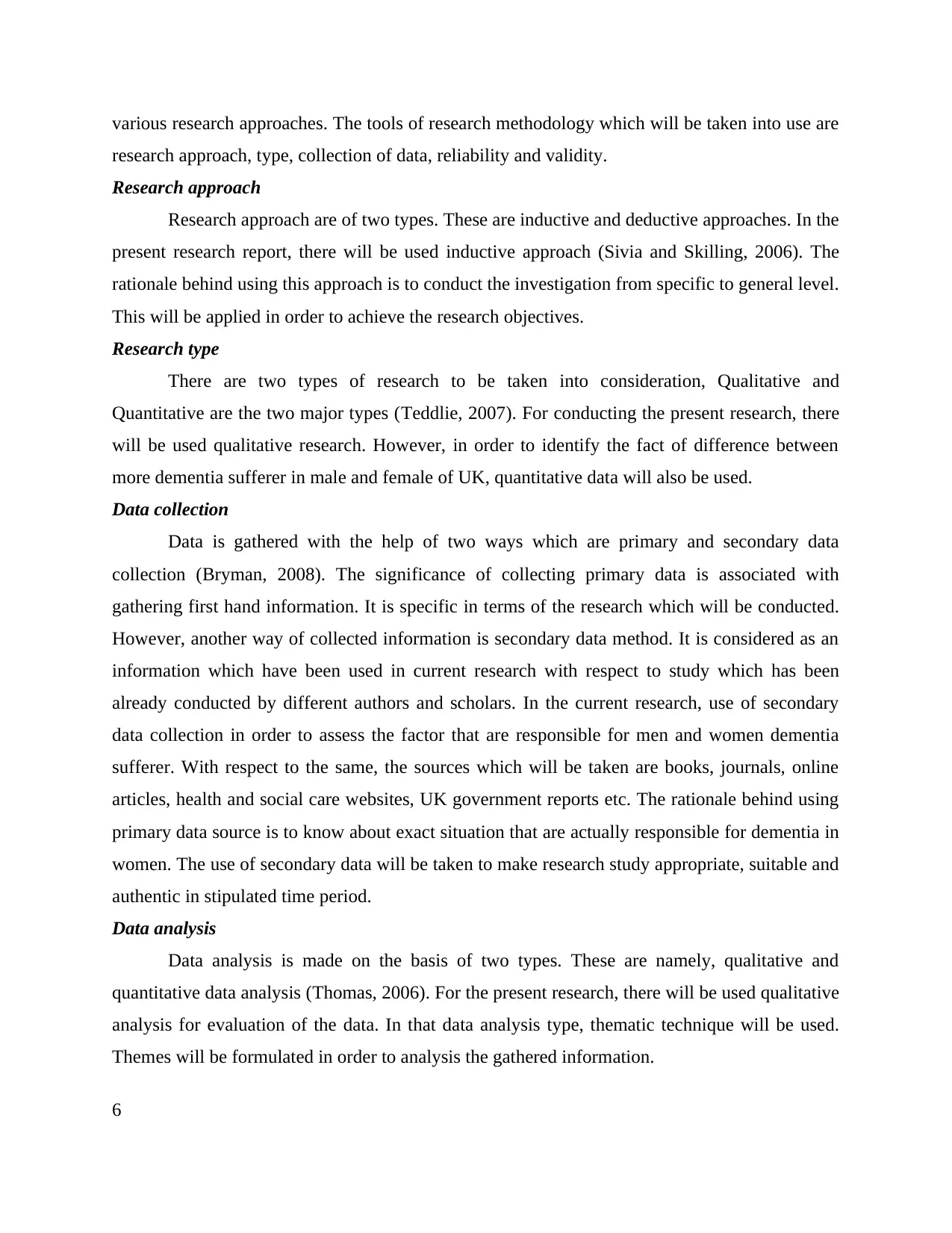
various research approaches. The tools of research methodology which will be taken into use are
research approach, type, collection of data, reliability and validity.
Research approach
Research approach are of two types. These are inductive and deductive approaches. In the
present research report, there will be used inductive approach (Sivia and Skilling, 2006). The
rationale behind using this approach is to conduct the investigation from specific to general level.
This will be applied in order to achieve the research objectives.
Research type
There are two types of research to be taken into consideration, Qualitative and
Quantitative are the two major types (Teddlie, 2007). For conducting the present research, there
will be used qualitative research. However, in order to identify the fact of difference between
more dementia sufferer in male and female of UK, quantitative data will also be used.
Data collection
Data is gathered with the help of two ways which are primary and secondary data
collection (Bryman, 2008). The significance of collecting primary data is associated with
gathering first hand information. It is specific in terms of the research which will be conducted.
However, another way of collected information is secondary data method. It is considered as an
information which have been used in current research with respect to study which has been
already conducted by different authors and scholars. In the current research, use of secondary
data collection in order to assess the factor that are responsible for men and women dementia
sufferer. With respect to the same, the sources which will be taken are books, journals, online
articles, health and social care websites, UK government reports etc. The rationale behind using
primary data source is to know about exact situation that are actually responsible for dementia in
women. The use of secondary data will be taken to make research study appropriate, suitable and
authentic in stipulated time period.
Data analysis
Data analysis is made on the basis of two types. These are namely, qualitative and
quantitative data analysis (Thomas, 2006). For the present research, there will be used qualitative
analysis for evaluation of the data. In that data analysis type, thematic technique will be used.
Themes will be formulated in order to analysis the gathered information.
6
research approach, type, collection of data, reliability and validity.
Research approach
Research approach are of two types. These are inductive and deductive approaches. In the
present research report, there will be used inductive approach (Sivia and Skilling, 2006). The
rationale behind using this approach is to conduct the investigation from specific to general level.
This will be applied in order to achieve the research objectives.
Research type
There are two types of research to be taken into consideration, Qualitative and
Quantitative are the two major types (Teddlie, 2007). For conducting the present research, there
will be used qualitative research. However, in order to identify the fact of difference between
more dementia sufferer in male and female of UK, quantitative data will also be used.
Data collection
Data is gathered with the help of two ways which are primary and secondary data
collection (Bryman, 2008). The significance of collecting primary data is associated with
gathering first hand information. It is specific in terms of the research which will be conducted.
However, another way of collected information is secondary data method. It is considered as an
information which have been used in current research with respect to study which has been
already conducted by different authors and scholars. In the current research, use of secondary
data collection in order to assess the factor that are responsible for men and women dementia
sufferer. With respect to the same, the sources which will be taken are books, journals, online
articles, health and social care websites, UK government reports etc. The rationale behind using
primary data source is to know about exact situation that are actually responsible for dementia in
women. The use of secondary data will be taken to make research study appropriate, suitable and
authentic in stipulated time period.
Data analysis
Data analysis is made on the basis of two types. These are namely, qualitative and
quantitative data analysis (Thomas, 2006). For the present research, there will be used qualitative
analysis for evaluation of the data. In that data analysis type, thematic technique will be used.
Themes will be formulated in order to analysis the gathered information.
6
⊘ This is a preview!⊘
Do you want full access?
Subscribe today to unlock all pages.

Trusted by 1+ million students worldwide
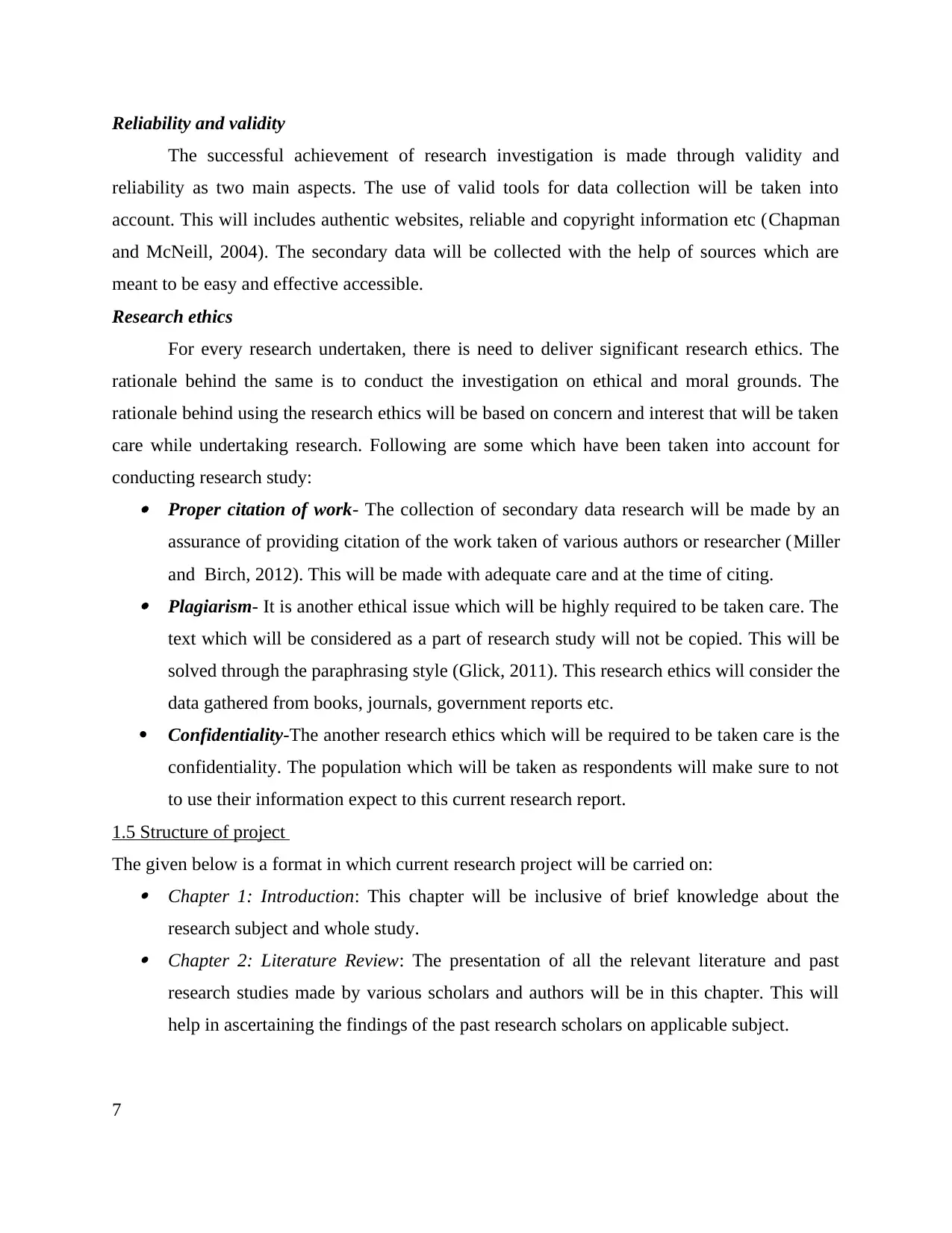
Reliability and validity
The successful achievement of research investigation is made through validity and
reliability as two main aspects. The use of valid tools for data collection will be taken into
account. This will includes authentic websites, reliable and copyright information etc (Chapman
and McNeill, 2004). The secondary data will be collected with the help of sources which are
meant to be easy and effective accessible.
Research ethics
For every research undertaken, there is need to deliver significant research ethics. The
rationale behind the same is to conduct the investigation on ethical and moral grounds. The
rationale behind using the research ethics will be based on concern and interest that will be taken
care while undertaking research. Following are some which have been taken into account for
conducting research study: Proper citation of work- The collection of secondary data research will be made by an
assurance of providing citation of the work taken of various authors or researcher (Miller
and Birch, 2012). This will be made with adequate care and at the time of citing. Plagiarism- It is another ethical issue which will be highly required to be taken care. The
text which will be considered as a part of research study will not be copied. This will be
solved through the paraphrasing style (Glick, 2011). This research ethics will consider the
data gathered from books, journals, government reports etc.
Confidentiality-The another research ethics which will be required to be taken care is the
confidentiality. The population which will be taken as respondents will make sure to not
to use their information expect to this current research report.
1.5 Structure of project
The given below is a format in which current research project will be carried on: Chapter 1: Introduction: This chapter will be inclusive of brief knowledge about the
research subject and whole study. Chapter 2: Literature Review: The presentation of all the relevant literature and past
research studies made by various scholars and authors will be in this chapter. This will
help in ascertaining the findings of the past research scholars on applicable subject.
7
The successful achievement of research investigation is made through validity and
reliability as two main aspects. The use of valid tools for data collection will be taken into
account. This will includes authentic websites, reliable and copyright information etc (Chapman
and McNeill, 2004). The secondary data will be collected with the help of sources which are
meant to be easy and effective accessible.
Research ethics
For every research undertaken, there is need to deliver significant research ethics. The
rationale behind the same is to conduct the investigation on ethical and moral grounds. The
rationale behind using the research ethics will be based on concern and interest that will be taken
care while undertaking research. Following are some which have been taken into account for
conducting research study: Proper citation of work- The collection of secondary data research will be made by an
assurance of providing citation of the work taken of various authors or researcher (Miller
and Birch, 2012). This will be made with adequate care and at the time of citing. Plagiarism- It is another ethical issue which will be highly required to be taken care. The
text which will be considered as a part of research study will not be copied. This will be
solved through the paraphrasing style (Glick, 2011). This research ethics will consider the
data gathered from books, journals, government reports etc.
Confidentiality-The another research ethics which will be required to be taken care is the
confidentiality. The population which will be taken as respondents will make sure to not
to use their information expect to this current research report.
1.5 Structure of project
The given below is a format in which current research project will be carried on: Chapter 1: Introduction: This chapter will be inclusive of brief knowledge about the
research subject and whole study. Chapter 2: Literature Review: The presentation of all the relevant literature and past
research studies made by various scholars and authors will be in this chapter. This will
help in ascertaining the findings of the past research scholars on applicable subject.
7
Paraphrase This Document
Need a fresh take? Get an instant paraphrase of this document with our AI Paraphraser
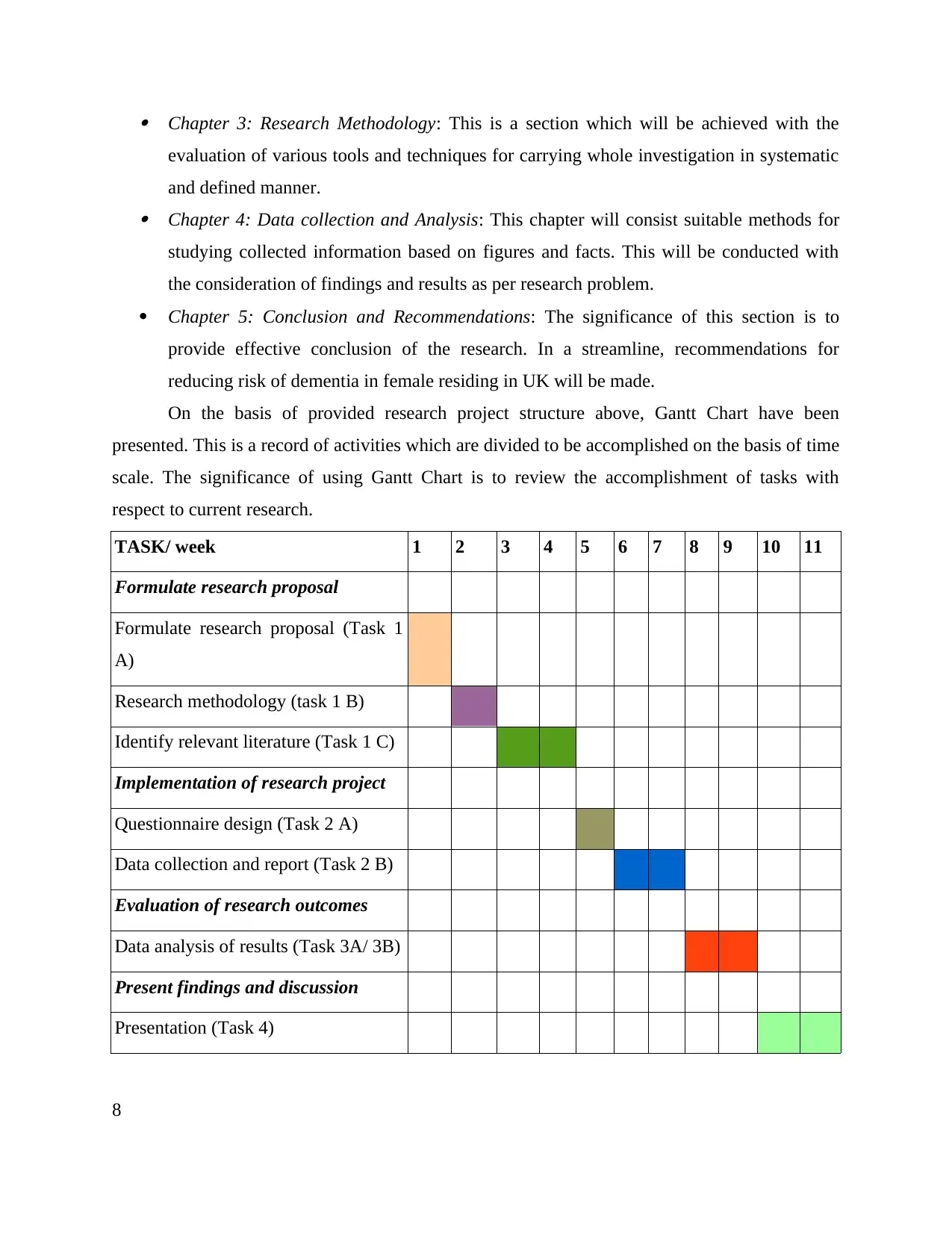
Chapter 3: Research Methodology: This is a section which will be achieved with the
evaluation of various tools and techniques for carrying whole investigation in systematic
and defined manner. Chapter 4: Data collection and Analysis: This chapter will consist suitable methods for
studying collected information based on figures and facts. This will be conducted with
the consideration of findings and results as per research problem.
Chapter 5: Conclusion and Recommendations: The significance of this section is to
provide effective conclusion of the research. In a streamline, recommendations for
reducing risk of dementia in female residing in UK will be made.
On the basis of provided research project structure above, Gantt Chart have been
presented. This is a record of activities which are divided to be accomplished on the basis of time
scale. The significance of using Gantt Chart is to review the accomplishment of tasks with
respect to current research.
TASK/ week 1 2 3 4 5 6 7 8 9 10 11
Formulate research proposal
Formulate research proposal (Task 1
A)
Research methodology (task 1 B)
Identify relevant literature (Task 1 C)
Implementation of research project
Questionnaire design (Task 2 A)
Data collection and report (Task 2 B)
Evaluation of research outcomes
Data analysis of results (Task 3A/ 3B)
Present findings and discussion
Presentation (Task 4)
8
evaluation of various tools and techniques for carrying whole investigation in systematic
and defined manner. Chapter 4: Data collection and Analysis: This chapter will consist suitable methods for
studying collected information based on figures and facts. This will be conducted with
the consideration of findings and results as per research problem.
Chapter 5: Conclusion and Recommendations: The significance of this section is to
provide effective conclusion of the research. In a streamline, recommendations for
reducing risk of dementia in female residing in UK will be made.
On the basis of provided research project structure above, Gantt Chart have been
presented. This is a record of activities which are divided to be accomplished on the basis of time
scale. The significance of using Gantt Chart is to review the accomplishment of tasks with
respect to current research.
TASK/ week 1 2 3 4 5 6 7 8 9 10 11
Formulate research proposal
Formulate research proposal (Task 1
A)
Research methodology (task 1 B)
Identify relevant literature (Task 1 C)
Implementation of research project
Questionnaire design (Task 2 A)
Data collection and report (Task 2 B)
Evaluation of research outcomes
Data analysis of results (Task 3A/ 3B)
Present findings and discussion
Presentation (Task 4)
8

9
⊘ This is a preview!⊘
Do you want full access?
Subscribe today to unlock all pages.

Trusted by 1+ million students worldwide
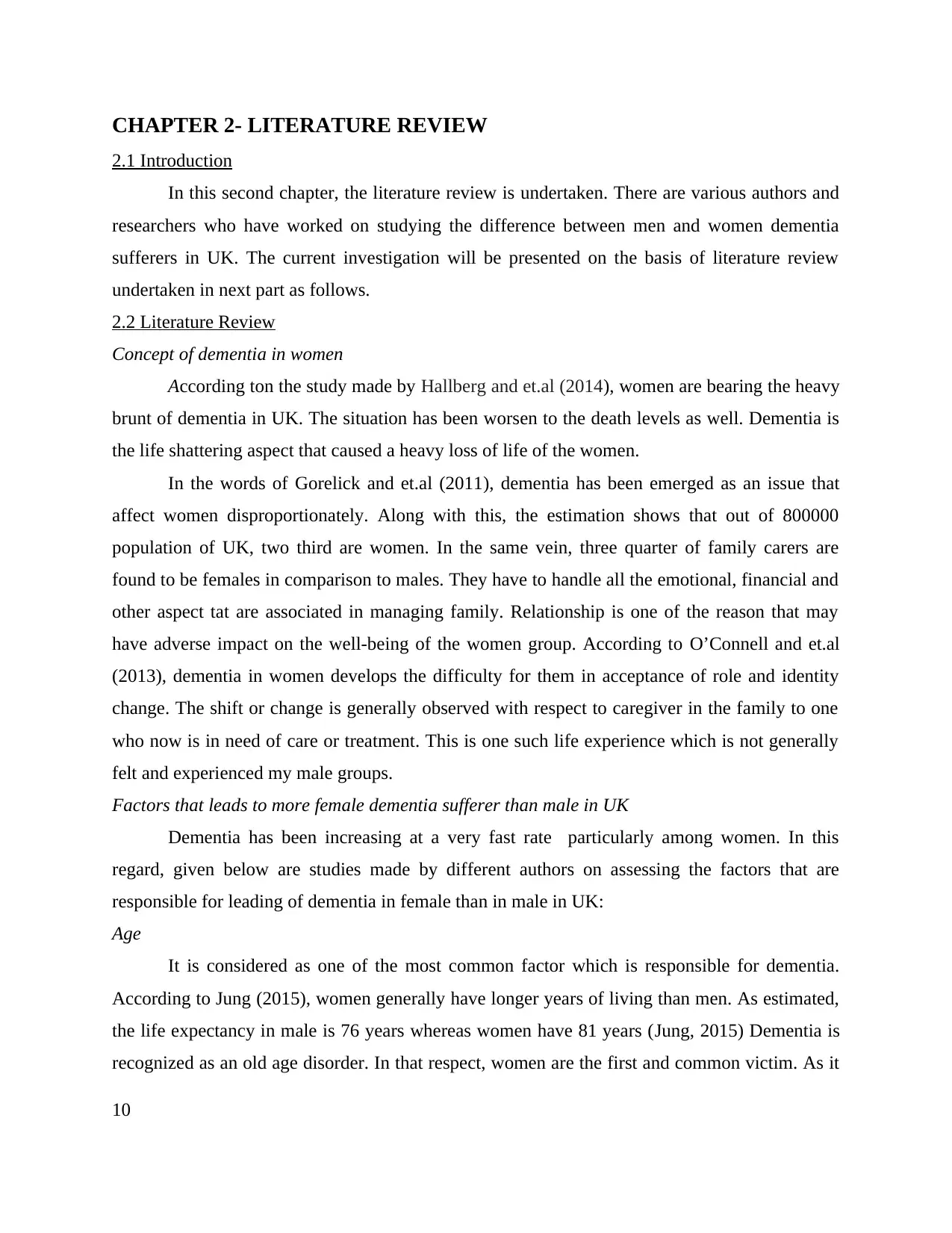
CHAPTER 2- LITERATURE REVIEW
2.1 Introduction
In this second chapter, the literature review is undertaken. There are various authors and
researchers who have worked on studying the difference between men and women dementia
sufferers in UK. The current investigation will be presented on the basis of literature review
undertaken in next part as follows.
2.2 Literature Review
Concept of dementia in women
According ton the study made by Hallberg and et.al (2014), women are bearing the heavy
brunt of dementia in UK. The situation has been worsen to the death levels as well. Dementia is
the life shattering aspect that caused a heavy loss of life of the women.
In the words of Gorelick and et.al (2011), dementia has been emerged as an issue that
affect women disproportionately. Along with this, the estimation shows that out of 800000
population of UK, two third are women. In the same vein, three quarter of family carers are
found to be females in comparison to males. They have to handle all the emotional, financial and
other aspect tat are associated in managing family. Relationship is one of the reason that may
have adverse impact on the well-being of the women group. According to O’Connell and et.al
(2013), dementia in women develops the difficulty for them in acceptance of role and identity
change. The shift or change is generally observed with respect to caregiver in the family to one
who now is in need of care or treatment. This is one such life experience which is not generally
felt and experienced my male groups.
Factors that leads to more female dementia sufferer than male in UK
Dementia has been increasing at a very fast rate particularly among women. In this
regard, given below are studies made by different authors on assessing the factors that are
responsible for leading of dementia in female than in male in UK:
Age
It is considered as one of the most common factor which is responsible for dementia.
According to Jung (2015), women generally have longer years of living than men. As estimated,
the life expectancy in male is 76 years whereas women have 81 years (Jung, 2015) Dementia is
recognized as an old age disorder. In that respect, women are the first and common victim. As it
10
2.1 Introduction
In this second chapter, the literature review is undertaken. There are various authors and
researchers who have worked on studying the difference between men and women dementia
sufferers in UK. The current investigation will be presented on the basis of literature review
undertaken in next part as follows.
2.2 Literature Review
Concept of dementia in women
According ton the study made by Hallberg and et.al (2014), women are bearing the heavy
brunt of dementia in UK. The situation has been worsen to the death levels as well. Dementia is
the life shattering aspect that caused a heavy loss of life of the women.
In the words of Gorelick and et.al (2011), dementia has been emerged as an issue that
affect women disproportionately. Along with this, the estimation shows that out of 800000
population of UK, two third are women. In the same vein, three quarter of family carers are
found to be females in comparison to males. They have to handle all the emotional, financial and
other aspect tat are associated in managing family. Relationship is one of the reason that may
have adverse impact on the well-being of the women group. According to O’Connell and et.al
(2013), dementia in women develops the difficulty for them in acceptance of role and identity
change. The shift or change is generally observed with respect to caregiver in the family to one
who now is in need of care or treatment. This is one such life experience which is not generally
felt and experienced my male groups.
Factors that leads to more female dementia sufferer than male in UK
Dementia has been increasing at a very fast rate particularly among women. In this
regard, given below are studies made by different authors on assessing the factors that are
responsible for leading of dementia in female than in male in UK:
Age
It is considered as one of the most common factor which is responsible for dementia.
According to Jung (2015), women generally have longer years of living than men. As estimated,
the life expectancy in male is 76 years whereas women have 81 years (Jung, 2015) Dementia is
recognized as an old age disorder. In that respect, women are the first and common victim. As it
10
Paraphrase This Document
Need a fresh take? Get an instant paraphrase of this document with our AI Paraphraser
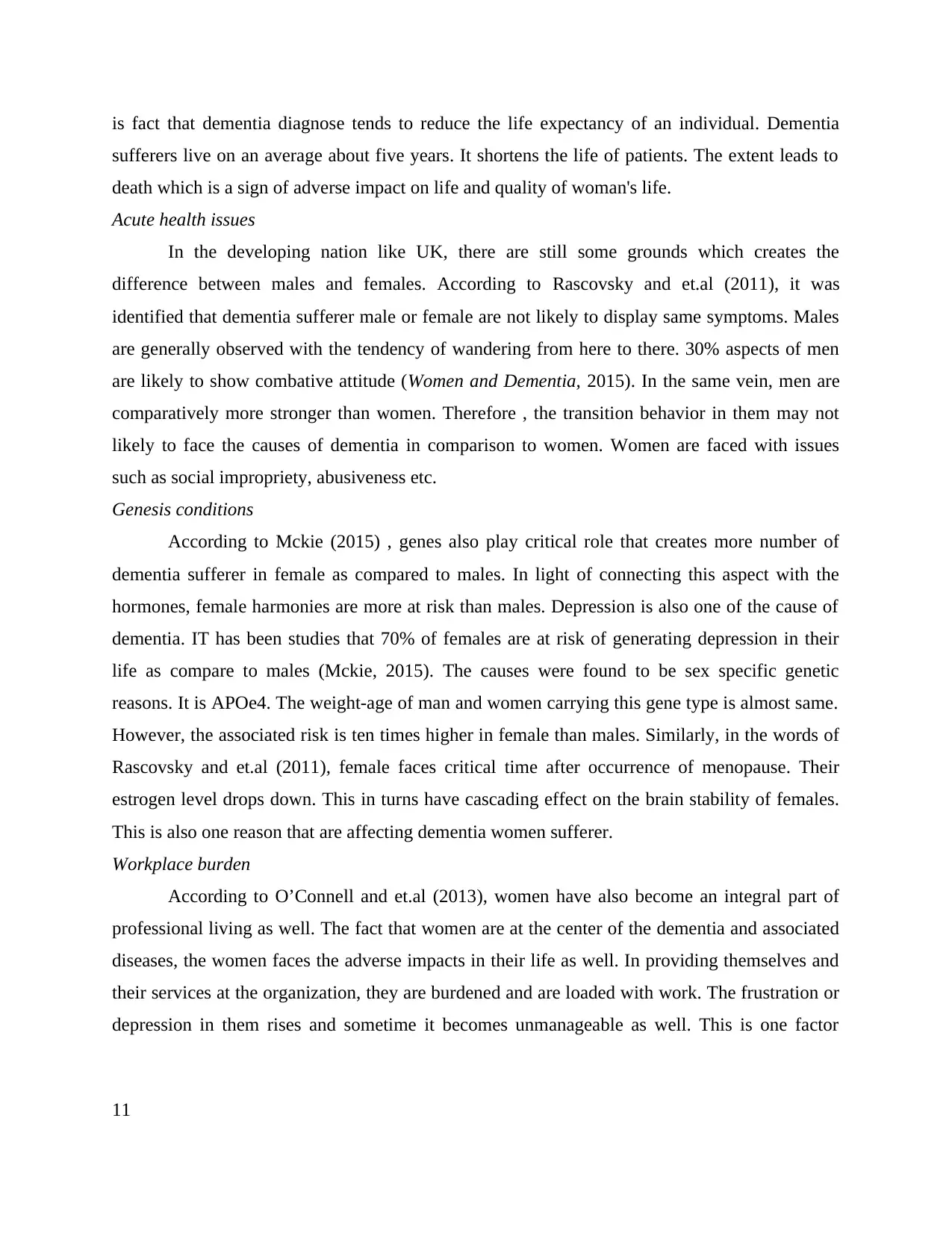
is fact that dementia diagnose tends to reduce the life expectancy of an individual. Dementia
sufferers live on an average about five years. It shortens the life of patients. The extent leads to
death which is a sign of adverse impact on life and quality of woman's life.
Acute health issues
In the developing nation like UK, there are still some grounds which creates the
difference between males and females. According to Rascovsky and et.al (2011), it was
identified that dementia sufferer male or female are not likely to display same symptoms. Males
are generally observed with the tendency of wandering from here to there. 30% aspects of men
are likely to show combative attitude (Women and Dementia, 2015). In the same vein, men are
comparatively more stronger than women. Therefore , the transition behavior in them may not
likely to face the causes of dementia in comparison to women. Women are faced with issues
such as social impropriety, abusiveness etc.
Genesis conditions
According to Mckie (2015) , genes also play critical role that creates more number of
dementia sufferer in female as compared to males. In light of connecting this aspect with the
hormones, female harmonies are more at risk than males. Depression is also one of the cause of
dementia. IT has been studies that 70% of females are at risk of generating depression in their
life as compare to males (Mckie, 2015). The causes were found to be sex specific genetic
reasons. It is APOe4. The weight-age of man and women carrying this gene type is almost same.
However, the associated risk is ten times higher in female than males. Similarly, in the words of
Rascovsky and et.al (2011), female faces critical time after occurrence of menopause. Their
estrogen level drops down. This in turns have cascading effect on the brain stability of females.
This is also one reason that are affecting dementia women sufferer.
Workplace burden
According to O’Connell and et.al (2013), women have also become an integral part of
professional living as well. The fact that women are at the center of the dementia and associated
diseases, the women faces the adverse impacts in their life as well. In providing themselves and
their services at the organization, they are burdened and are loaded with work. The frustration or
depression in them rises and sometime it becomes unmanageable as well. This is one factor
11
sufferers live on an average about five years. It shortens the life of patients. The extent leads to
death which is a sign of adverse impact on life and quality of woman's life.
Acute health issues
In the developing nation like UK, there are still some grounds which creates the
difference between males and females. According to Rascovsky and et.al (2011), it was
identified that dementia sufferer male or female are not likely to display same symptoms. Males
are generally observed with the tendency of wandering from here to there. 30% aspects of men
are likely to show combative attitude (Women and Dementia, 2015). In the same vein, men are
comparatively more stronger than women. Therefore , the transition behavior in them may not
likely to face the causes of dementia in comparison to women. Women are faced with issues
such as social impropriety, abusiveness etc.
Genesis conditions
According to Mckie (2015) , genes also play critical role that creates more number of
dementia sufferer in female as compared to males. In light of connecting this aspect with the
hormones, female harmonies are more at risk than males. Depression is also one of the cause of
dementia. IT has been studies that 70% of females are at risk of generating depression in their
life as compare to males (Mckie, 2015). The causes were found to be sex specific genetic
reasons. It is APOe4. The weight-age of man and women carrying this gene type is almost same.
However, the associated risk is ten times higher in female than males. Similarly, in the words of
Rascovsky and et.al (2011), female faces critical time after occurrence of menopause. Their
estrogen level drops down. This in turns have cascading effect on the brain stability of females.
This is also one reason that are affecting dementia women sufferer.
Workplace burden
According to O’Connell and et.al (2013), women have also become an integral part of
professional living as well. The fact that women are at the center of the dementia and associated
diseases, the women faces the adverse impacts in their life as well. In providing themselves and
their services at the organization, they are burdened and are loaded with work. The frustration or
depression in them rises and sometime it becomes unmanageable as well. This is one factor
11
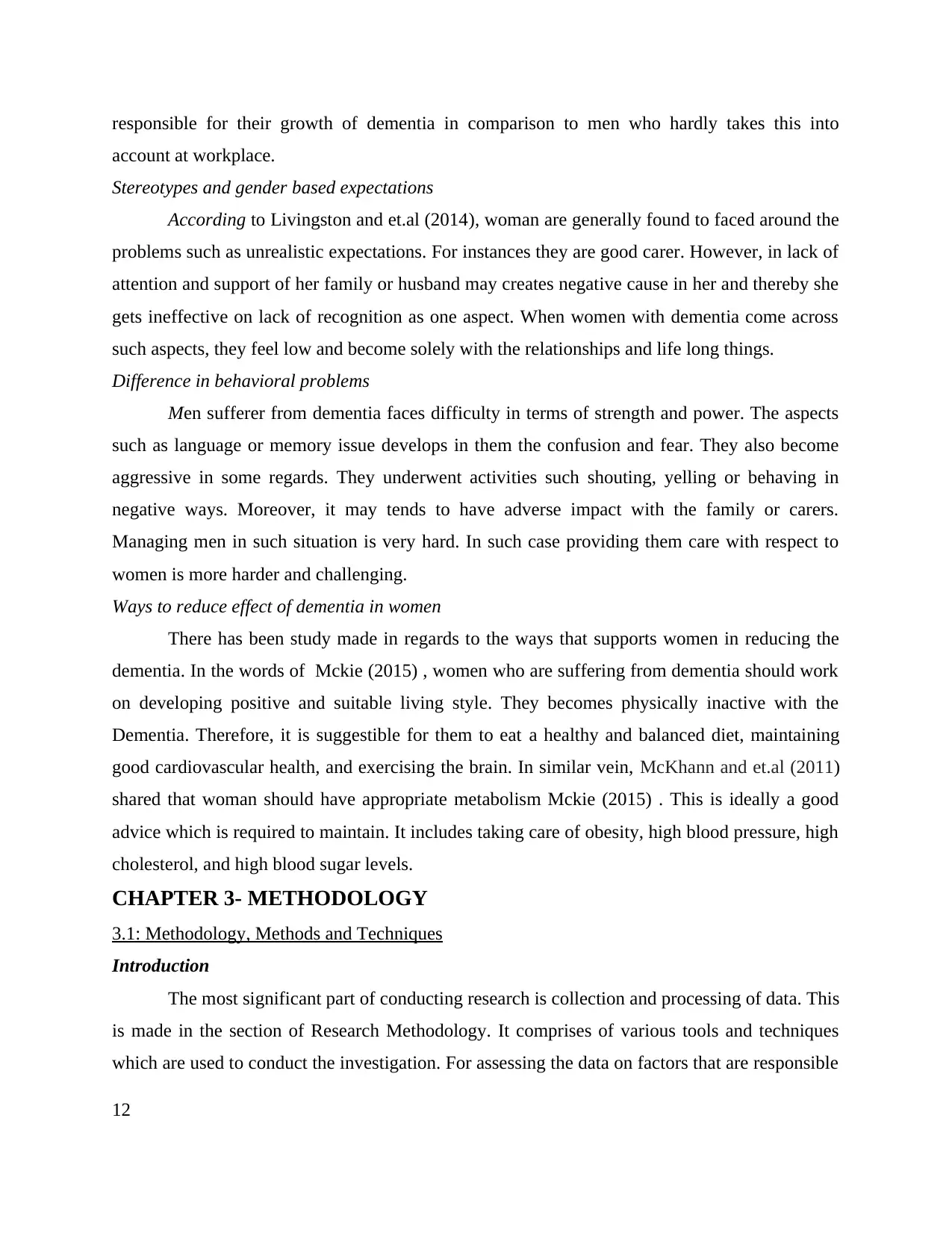
responsible for their growth of dementia in comparison to men who hardly takes this into
account at workplace.
Stereotypes and gender based expectations
According to Livingston and et.al (2014), woman are generally found to faced around the
problems such as unrealistic expectations. For instances they are good carer. However, in lack of
attention and support of her family or husband may creates negative cause in her and thereby she
gets ineffective on lack of recognition as one aspect. When women with dementia come across
such aspects, they feel low and become solely with the relationships and life long things.
Difference in behavioral problems
Men sufferer from dementia faces difficulty in terms of strength and power. The aspects
such as language or memory issue develops in them the confusion and fear. They also become
aggressive in some regards. They underwent activities such shouting, yelling or behaving in
negative ways. Moreover, it may tends to have adverse impact with the family or carers.
Managing men in such situation is very hard. In such case providing them care with respect to
women is more harder and challenging.
Ways to reduce effect of dementia in women
There has been study made in regards to the ways that supports women in reducing the
dementia. In the words of Mckie (2015) , women who are suffering from dementia should work
on developing positive and suitable living style. They becomes physically inactive with the
Dementia. Therefore, it is suggestible for them to eat a healthy and balanced diet, maintaining
good cardiovascular health, and exercising the brain. In similar vein, McKhann and et.al (2011)
shared that woman should have appropriate metabolism Mckie (2015) . This is ideally a good
advice which is required to maintain. It includes taking care of obesity, high blood pressure, high
cholesterol, and high blood sugar levels.
CHAPTER 3- METHODOLOGY
3.1: Methodology, Methods and Techniques
Introduction
The most significant part of conducting research is collection and processing of data. This
is made in the section of Research Methodology. It comprises of various tools and techniques
which are used to conduct the investigation. For assessing the data on factors that are responsible
12
account at workplace.
Stereotypes and gender based expectations
According to Livingston and et.al (2014), woman are generally found to faced around the
problems such as unrealistic expectations. For instances they are good carer. However, in lack of
attention and support of her family or husband may creates negative cause in her and thereby she
gets ineffective on lack of recognition as one aspect. When women with dementia come across
such aspects, they feel low and become solely with the relationships and life long things.
Difference in behavioral problems
Men sufferer from dementia faces difficulty in terms of strength and power. The aspects
such as language or memory issue develops in them the confusion and fear. They also become
aggressive in some regards. They underwent activities such shouting, yelling or behaving in
negative ways. Moreover, it may tends to have adverse impact with the family or carers.
Managing men in such situation is very hard. In such case providing them care with respect to
women is more harder and challenging.
Ways to reduce effect of dementia in women
There has been study made in regards to the ways that supports women in reducing the
dementia. In the words of Mckie (2015) , women who are suffering from dementia should work
on developing positive and suitable living style. They becomes physically inactive with the
Dementia. Therefore, it is suggestible for them to eat a healthy and balanced diet, maintaining
good cardiovascular health, and exercising the brain. In similar vein, McKhann and et.al (2011)
shared that woman should have appropriate metabolism Mckie (2015) . This is ideally a good
advice which is required to maintain. It includes taking care of obesity, high blood pressure, high
cholesterol, and high blood sugar levels.
CHAPTER 3- METHODOLOGY
3.1: Methodology, Methods and Techniques
Introduction
The most significant part of conducting research is collection and processing of data. This
is made in the section of Research Methodology. It comprises of various tools and techniques
which are used to conduct the investigation. For assessing the data on factors that are responsible
12
⊘ This is a preview!⊘
Do you want full access?
Subscribe today to unlock all pages.

Trusted by 1+ million students worldwide
1 out of 20
Related Documents
Your All-in-One AI-Powered Toolkit for Academic Success.
+13062052269
info@desklib.com
Available 24*7 on WhatsApp / Email
![[object Object]](/_next/static/media/star-bottom.7253800d.svg)
Unlock your academic potential
Copyright © 2020–2025 A2Z Services. All Rights Reserved. Developed and managed by ZUCOL.





